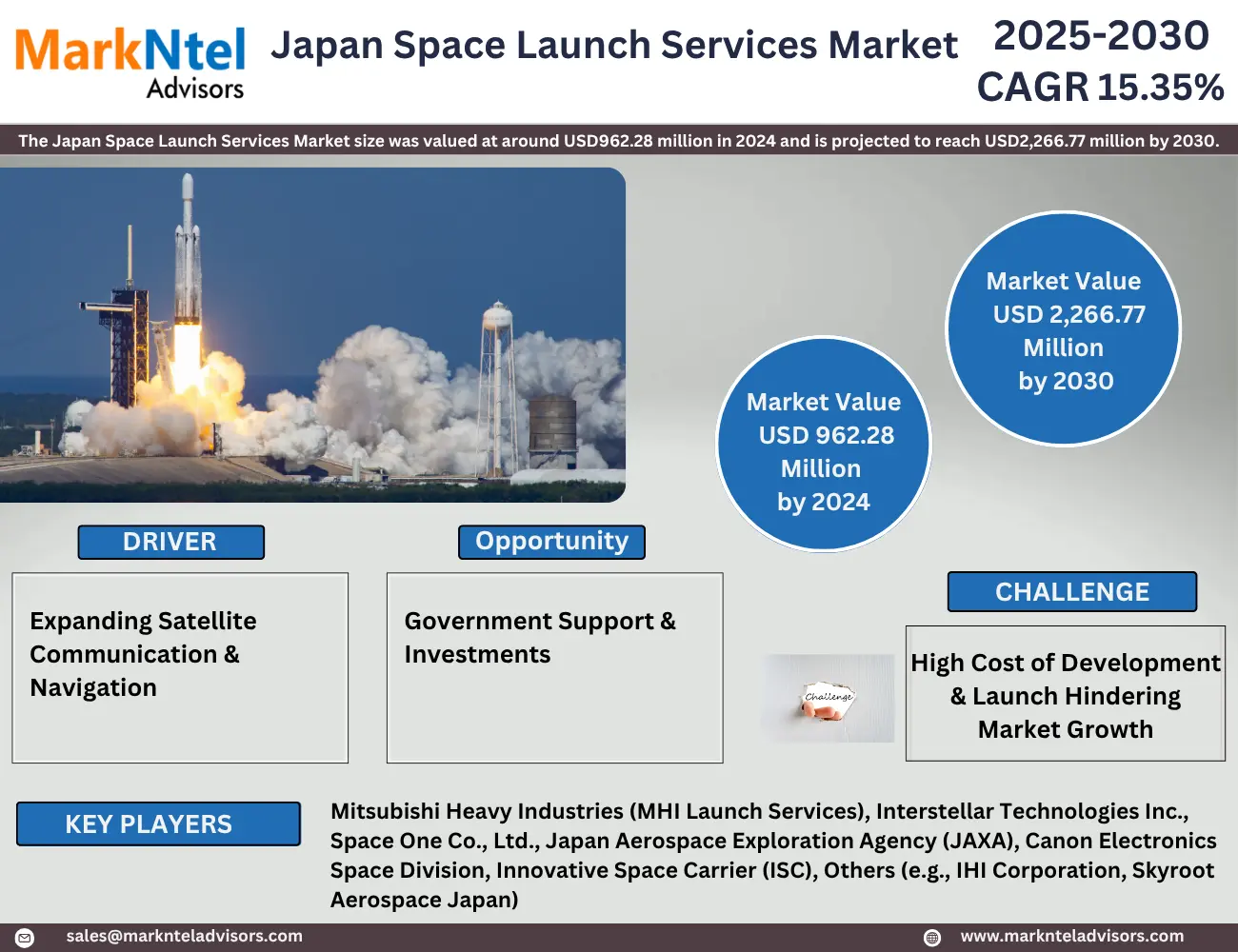Press Release Description
Japan Space Launch Services Market to Witness a Steady CAGR of Around 15.35% During 2025-30
The Japan Space Launch Services Market size was valued at around USD962.28 million in 2024 and is projected to reach USD2,266.77 million by 2030. Along with this, the market is estimated to grow at a CAGR of around 15.35% during the forecast period, i.e., 2025-30, cites MarkNtel Advisors in the recent research report. The rise in the market is due to an increase in the need for self-reliant navigation & communication systems, the rising space tourism industry, government support, growing investments in technology, the need for accurate and precise forecasts in the Earth observatory, and others.
The growing need for satellites in sectors such as navigation, communication, and observatories has increased lately due to the need for real-time monitoring of changing climatic conditions, physical features, and others, adoption of smartphones & 5G internet services, rising remote working culture, etc. The navigation and communication sector of Japan is solely dependent on the US GPS navigation system; thus, to become an independent nation for these services, the increasing penetration of electronic devices has pushed the authorities to launch their navigation system, QZSS, with 5 satellites, in 2025.

Moreover, the technological advances across numerous industries, including the space industry, have increased. The upgradations in the launching services, such as rideshare missions, in which multiple payloads can be launched. Similarly, the reusable launch vehicles (RLVs) are a sustainable approach, in which the launcher returns to the Earth's surface after launching the payload. Several service providers like Innovation Space Carrier (ISC), Space One, Interstellar Technologies, etc., are offering these services.
Therefore, the increasing investments, increasing inclination of consumers and the government towards reusable alternatives, and the growing multiple sectors such as telecommunication, observatory, etc., boost the demand for space launches in Japan, further states the research report, “Japan Space Launch Services Market Analysis, 2025.”
Segmentation Analysis
Small Satellite Launch Vehicles Segment Holds the Largest Market Share
Based on the product type, the market is further bifurcated into small satellite launch vehicles, Medium-Lift Launch Vehicles, Heavy-Lift Launch Vehicles, and reusable rocket systems. The small satellite launch vehicles hold the majority of the market share, around 41%. This is due to the advanced technologies, frequent launches of payloads, increasing investments, reduced size of the devices, etc.
The advances in technology, like nanotechnology and micro-technology, have resulted in compact devices and components integrated in the launchers and rockets. The reduced size of the integrated components and devices further minimizes the size of payloads, resulting in the need for small satellite vehicles. The compact size and lower load require small satellite vehicles for launching and are cost-effective. It further speeds up the launching process, as a result, it is widely used in the telecommunication, earth observatory, and scientific research sectors. Thus, the cost-efficient and fast procedure of launching the new advanced miniature-sized payloads has increased the demand for this segment in the industry.
Launch Services Generating Maximum Market Revenue
Launch services (orbital, suborbital) dominate the space launch services industry in Japan with a market share of around 52%. This is due to the well-established launch ports along the coastline, international collaborations with the US and India, inclination towards space tourism, increasing investments by the government and private sector, etc.
The demand for launching services has surged in Japan due to the strategic location of launching pads and ports along the coastline. The position of the launching pads near the water bodies reduces the risk caused due to technical errors and operational inefficiency. The investment of the Japanese government through JAXA and the Ministry of Economy, Trade and Industry in funding programs like the Space Strategy Funds, and offering financial support to the start-ups attracts the launching service providers to the nation for launches and expansion. Thus, the increasing investments, collaborations, and strategic location of the launch centers increase the demand for launch services, hence, facilitating its largest market share among the others in Japan.
Competitive Landscape
With strategic initiatives, such as mergers, collaborations, and acquisitions, the leading market companies, including Mitsubishi Heavy Industries (MHI Launch Services), Interstellar Technologies Inc., Space One Co., Ltd., Japan Aerospace Exploration Agency (JAXA), Canon Electronics Space Division, Innovative Space Carrier (ISC), and others (IHI Corporation, Skyroot Aerospace Japan, etc.), are looking forward to strengthening their market positions.
Key Questions Answered in the Research Report
- What are the industry’s overall statistics or estimates (Overview, Size- By Value, Forecast Numbers, Segmentation, Shares)?
- What are the trends influencing the current scenario of the market?
- What key factors would propel and impede the industry across the country?
- How has the industry been evolving in terms of geography & solution adoption?
- How has the competition been shaping up across the country?
- How have buying behavior, customer inclination, and expectations from solution providers been evolving during 2020-30?
- Who are the key competitors, and what strategic partnerships or ventures are they coming up with to stay afloat during the projected time frame?
We offer flexible licensing options to cater to varying organizational needs. Choose the pricing pack that best suits your requirements:
Buy NowNeed Assistance?
WRITE AN EMAIL
sales@marknteladvisors.comCustomization Offered
100% Safe & Secure
Strongest encryption on the website to make your purchase safe and secure
